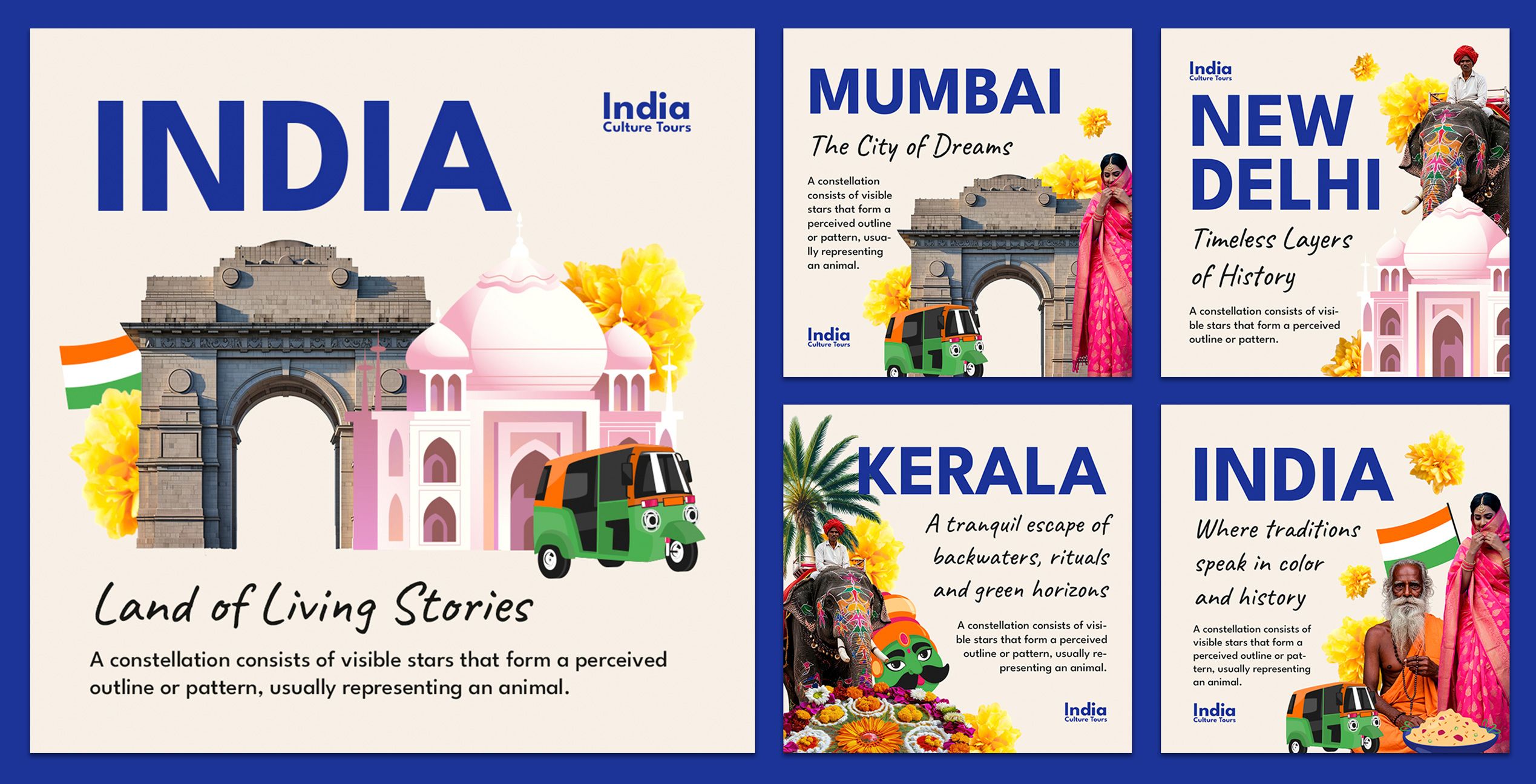Drivers of Cultural Exchange and Economic Growth, India is a country with many picturesque places, dense history and deep spiritual heritage. Individuals around the world travel to India to witness their impressive natural beauty, historical places, vibrant festivals and indigenous cultures. To facilitate and promote this interest in tourism in India, there were special events initiated such as Tourism Marts. They are large business meetings, where travel companies, hoteliers, tour operators and state tourism authorities talk, exchange thoughts, make agreements and help each other in Indian destinations marketing. These meetings help attract more tourists, get more revenue and support local businesses.
During the year 2023, the tourism industry in India generated about 19.13 trillion (or $230 billion) for the country's revenue. This represented approximately 9.2% of India's general economy. Tourism also created more than 43 million jobs, one of the largest employment sectors in the country. After the COVID-19 pandemic, domestic tourism recovered extensively. In 2023, more than 1.7 billion trips were made by Indian citizens. This has increased due to an increase in individuals with smartphones, better internet connectivity and an increase in interest to travel in their own country. Foreign tourist arrivals have also increased, with more than 15 million foreigners visiting India. Kerala, Rajasthan, Goa and Himachal Pradesh were among the most turned destinations.
The concept of tourism Marts in India was inspired by mega global travel programs such as ITB Berlin in Germany and WTM London in the United Kingdom. India's tourism sector was increasing during the 1990s, and individuals realized that it was imperative to link local travel companies to international buyers. It was when organizations such as India Tourism Mart, Southern Asia Travel and Tourism Exchange (Satte), Kerala Travel Mart and Great Indian Travel Bazaar were started. These events have become popular platforms for travel agencies to display what they have to offer and connect with international partners. They helped India become more visible on the World Tourism Map.
These travel milestones proved to be quite useful to show the numerous travel points in India. For example, Kerala Travel Mart focuses on health and Wellness tourism, walking for nature and responsible tourism. Rajasthan's travel road shows the palaces, deserts and historical places of the state. In the northeast region of India, states such as Assam, Meghalaya and Arunachal Pradesh received impetus with the International Tourism Mart. Jammu and Kashmir are also promoted in these events with snow sports, pilgrimage tours and homes for boat houses. Coastal states like Goa and Maharashtra use marts to market their beaches, strong and medical tourism packages. These festivals contribute to bringing money to the locality, preserving cultural practices and developing community tourism.
The last five years indicate robust growth in tourism. In Kerala, tourism arrives grew from 11 million in 2018 to over 21 million in 2023. In Himachal Pradesh, the arrivals of indigenous tourists changed from 17 million by 2020 to 18 million in 2024. Foreign visitors grew from mere 5,000 to over 80,000 in the same state. Jammu and Kashmir suffered a significant boost of 2.5 million visitors by 2020 to 23.5 million by 2024. Foreign visitors increased from only 1,650 by 2021 to over 65,000 by 2024. This strongly indicates the impact that tourism and marketing activities have had.
Although tourism in India is developing rapidly, numerous questions still remain. Numerous tourist destinations continue to have bad roads, bad bathrooms and insufficient accommodations. Excessive tourists in some areas, such as Manali, Shimla and Wayanad, result in pollution and destruction of nature. Some states are marketed extensively, while others do not receive attention due to inappropriate financing or poor planning. There is also a shortage of qualified tourism workers, particularly individuals who speak foreign languages and are able to treat guests properly. Most small travel agencies don't know how to promote online, so they lose customers. In certain places, tourists feel insecure due to blows, lack of assistance or intimidation, especially for solitary travelers.
To overcome these issues, India requires improved planning and good government support and private companies. It is necessary to increase the investment in transportation, roads and cleaning in tourist destinations, particularly villages and distant areas. The development for tourism must be sustainable and therefore should not ruin the environment. Remote areas also need to be developed so that tourism can be evenly distributed. Training courses must be improved so that individuals get hospitality skills, linguistic skills and safety procedures. Technology should be used to improve tourist experience, such as travel applications, online directories and simple reserve systems. Tourist security should be prioritized with the tourist police, emergency care centers and legal assistance services.
Tourism Marts emerge as powerful instruments in promoting the reputation of India as a tourist nation. They help introduce the world to beauty, culture and diversity of what India can give. They have helped millions of tourists explore places and helped the local population make a living. But to continue growing in the right direction, India needs to address its problems with serious attempts and intelligent thoughts. With a combination of good policies, qualified individuals, emerging technology and respect for nature, Indian tourism can rise even more. This will not only attract more travelers, but will also offer more benefits to people and places across the country.
Tourism Marts are good ways to improve how people see India as a lively and interesting place to visit. They bring together local service, state tourism boards, and international buyers to make strong connections that help expanding knowledge about different religions and economic improvement. Because of many different experiences available in India, tourism marts allow millions of visitors to enjoy the amazing diversity of India - from grand monuments and holy places to tribal lifestyles and unknown areas. They helped local communities by providing jobs, income, and support for their culture.
In order to move forward and truly make India a tourism leader, there is a need to address issues of the past and develop more inclusive, modern, and sustainable culture.
A few of the ways through which India can advertise its tourism are as follows:
1. Popularize lesser locations: A push should be given to promote level 2 and 3 cities and lesser-visited locations like Odisha, Chhattisgarh, Bundelkhand, and the Northeast. This will reduce the influx of people to popular locations and spread economic opportunities across the country.
2. Develop themed tour circuits: India can develop and offer tour plans on the theme of history, wildlife, health and yoga, fabrics and religious ethics. The "Ramayana" or a "Buddhist Trail”, can be attractive to foreign tourists seeking spirituality and history on religious ethics.
3. Simplify visa and entry processes: Using the e-Visa program extensively, granting arrival visas, and easing airport immigration can make India welcoming to tourists, particularly impromptu ones.
4. Sustainable tourism: It provides a sustainable future of development without causing harm to the environment.
5. Development of Medical and Wellness Tourism: India is developing its brand name in cheap health care and Ayurveda, and can emerge as a centre of medical and wellness tourism, establish its infrastructure, make processes smoother and then provide packages to foreign patients.
6. Cultural Festivals and Mega Events: International event management and marketing of film festivals, art fairs and spiritual festivals (Kumbh Mela or Rann Utsav), can attract high footfalls and improve India's global image.
7. Authentic Digital Marketing: Small and medium-enterprise travel companies should be well-trained and aware of Digital SEO and social media marketing, in order to deal with negative online reputation and interact with influencers. Young travelers increasingly require a strong online presence.
8. Enhance Security Mechanisms: For the safety of women and single travelers, we require more police personnel, tourist police stations, and quick-response emergency apps. It enhances confidence across the globe.
9. Community-based Models of Tourism: One of the most effective means of developing sustainable tourism that would prove to be locally advantageous is to enable natives to act as tourism ambassadors by involving themselves in homestays, cultural festivals, food festivals, eco-tours, etc. In brief, due to the rapid growth due to tourism, the tourism industry in India is developing at a faster and better pace than we could even imagine.
To know more about travel and tourism and want us to plan your best travel experience with us call or WhatsApp at +91-9733533000 or you can visit https://www.marinetoalpine.com


